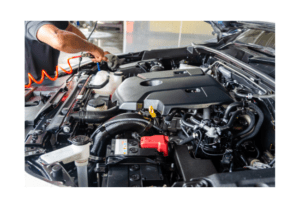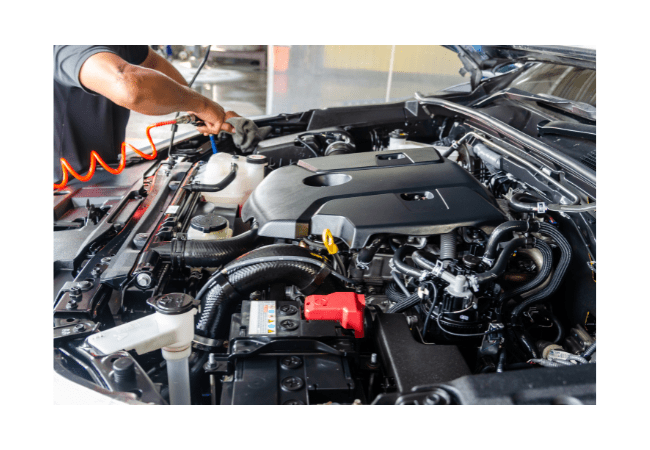The 5.7 Hemi engine is a V8 engine that was first introduced by Chrysler in 2003. This engine is commonly used in a variety of vehicles such as the Dodge Charger, Jeep Grand Cherokee, and RAM 1500. The engine’s intake manifold is responsible for delivering air to the engine’s cylinders, where it is mixed with fuel and ignited to produce power. The 5.7 Hemi’s intake manifold is made of plastic and is known to be a weak point in the engine’s design and will lead to a 5.7 Hemi intake manifold oil leak.
Oil leaks in the 5.7 Hemi engine’s intake manifold are a common issue that can lead to a range of problems. The plastic material used in the intake manifold can become brittle over time, causing cracks and leaks. These leaks can cause oil to seep into the engine’s combustion chamber, resulting in decreased engine performance, rough idling, and stalling. If left unaddressed, oil leaks can also lead to significant engine damage and costly repairs.
It is important to address oil leaks in the 5.7 Hemi engine’s intake manifold to avoid further damage to the engine and to ensure optimal engine performance. When oil leaks into the engine’s combustion chamber, it can cause fouling of the spark plugs and damage to the engine’s oxygen sensors. This can result in decreased fuel economy, increased emissions, and decreased power output. Additionally, oil leaks can cause safety hazards if oil drips onto the engine’s exhaust components, potentially leading to a fire. Regular maintenance and timely repair of oil leaks in the 5.7 Hemi engine’s intake manifold can help to ensure the longevity and safety of the engine.
Jump to
Causes of 5.7 Hemi Intake Manifold Oil Leak

Faulty gaskets and seals are a common cause of oil leaks in the 5.7 Hemi engine’s intake manifold. Gaskets and seals are used to create a tight seal between different engine components, such as the intake manifold and the engine block. Over time, gaskets and seals can become worn, cracked, or damaged, causing oil to leak out. This can be exacerbated by the high heat generated by the engine, which can cause gaskets and seals to deteriorate more quickly.
As the 5.7 Hemi engine’s intake manifold ages and accumulates mileage, it can become worn and damaged. The plastic material used in the intake manifold can become brittle and crack, causing oil leaks to occur. The more miles that the engine has been driven, the more likely it is that wear and tear will cause oil leaks in the intake manifold. Regular maintenance can help to catch and address issues before they become more severe.
Improper installation of the 5.7 Hemi engine’s intake manifold can also lead to oil leaks. If the bolts that hold the intake manifold in place are not tightened properly or if the gaskets and seals are not installed correctly, oil can leak out of the intake manifold. It is important to have the intake manifold installed by a qualified technician to ensure that it is installed correctly and to avoid potential issues down the road.
Engine overheating can also cause oil leaks in the 5.7 Hemi engine’s intake manifold. When the engine overheats, it can cause the plastic material used in the intake manifold to warp and crack. This can create gaps where oil can leak out. It is important to address engine overheating issues as soon as possible to prevent damage to the engine and the intake manifold. Regular maintenance can help to catch and address overheating issues before they become more severe.
Symptoms of 5.7 Hemi Intake Manifold Oil Leak
Oil leaks in the 5.7 Hemi engine’s intake manifold can cause decreased engine performance. Oil leaking into the engine’s combustion chamber can foul the spark plugs and affect the air/fuel mixture, leading to decreased power output and reduced fuel economy. This can be particularly noticeable during acceleration or when towing heavy loads. If you notice a decrease in engine performance, it’s important to have the engine inspected to identify and address the root cause of the issue.
Oil leaks in the 5.7 Hemi engine’s intake manifold can also cause rough idling and stalling. If oil is leaking into the engine’s combustion chamber, it can affect the combustion process and cause the engine to idle roughly or stall. This can be particularly noticeable when the engine is at idle, such as when you’re stopped at a traffic light. If you experience rough idling or stalling, it’s important to have the engine inspected to identify and address the root cause of the issue.
Oil leaks in the 5.7 Hemi engine’s intake manifold can also cause smoke or a burning smell. If oil is leaking onto the engine’s exhaust components, it can burn and create smoke and a burning smell. This can be particularly noticeable when the engine is under load or when you’re driving up hills. If you notice smoke or a burning smell coming from your engine compartment, it’s important to have the engine inspected to identify and address the root cause of the issue.
Oil leaks in the 5.7 Hemi engine’s intake manifold can also be visible in the engine compartment. If you notice oil on the engine or on the ground under your vehicle, it’s important to have the engine inspected to identify and address the root cause of the issue. Oil leaks can be a sign of a more serious issue and can lead to engine damage if left unaddressed.
Diagnosing 5.7 Hemi Intake Manifold Oil Leak
A visual inspection is the first step in diagnosing an oil leak in the 5.7 Hemi engine’s intake manifold. During a visual inspection, a technician will examine the engine compartment and intake manifold for signs of oil leakage, such as oil stains or puddles. They will also inspect the gaskets and seals for signs of wear or damage. A visual inspection can provide valuable information about the location and severity of the oil leak.
Pressurized testing is a more advanced diagnostic method that can help to identify the location and severity of an oil leak in the 5.7 Hemi engine’s intake manifold. During pressurized testing, a technician will use a special tool to pressurize the engine’s oil system. This will force oil through any leaks in the system, allowing the technician to pinpoint the location of the leak. Pressurized testing is a more accurate and efficient diagnostic method than a visual inspection.
Leak detection dye is a diagnostic tool that can be used to identify oil leaks in the 5.7 Hemi engine’s intake manifold. During a leak detection dye test, a technician will add a special dye to the engine’s oil system. The dye will flow through the engine’s oil system and seep out of any leaks, making them visible under UV light. Leak detection dye is a fast and efficient diagnostic tool that can help to identify leaks that might be difficult to detect otherwise.
There are a variety of other diagnostic tools that can be used to identify oil leaks in the 5.7 Hemi engine’s intake manifold. These include electronic leak detectors, which use sensors to detect the presence of oil vapors in the engine compartment, and thermal imaging cameras, which can detect changes in temperature that may indicate the location of a leak. A combination of diagnostic tools may be used to accurately diagnose and address an oil leak in the engine’s intake manifold.
Fixing 5.7 Hemi Intake Manifold Oil Leak
Replacing gaskets and seals is a common repair option for addressing oil leaks in the 5.7 Hemi engine’s intake manifold. During this repair, a technician will remove the intake manifold and replace the gaskets and seals that are responsible for creating a tight seal between the intake manifold and the engine block. This repair can help to eliminate oil leaks and improve engine performance.
Tightening or replacing bolts that hold the 5.7 Hemi engine’s intake manifold in place is another repair option for addressing oil leaks. Over time, bolts can become loose, leading to oil leaks. In some cases, the bolts may need to be replaced if they have become damaged or worn. A technician can inspect the bolts and determine if they need to be tightened or replaced.
Cleaning the 5.7 Hemi engine is another repair option for addressing oil leaks in the intake manifold. Oil leaks can sometimes be caused by debris or buildup in the engine, which can affect the performance of gaskets and seals. A technician can clean the engine to remove any buildup or debris that may be contributing to oil leaks. This can help to improve engine performance and prevent future oil leaks.
In some cases, other repair options may be necessary to address oil leaks in the 5.7 Hemi engine’s intake manifold. For example, if the intake manifold has become cracked or damaged, it may need to be replaced. In some cases, the engine may need to be rebuilt or replaced if the damage is severe. A technician can evaluate the extent of the damage and recommend the best course of action for addressing the issue.
Preventing 5.7 Hemi Intake Manifold Oil Leak
Regular maintenance is a crucial preventative measure for avoiding oil leaks in the 5.7 Hemi engine’s intake manifold. This includes changing the engine oil and filter at recommended intervals, inspecting the engine and intake manifold for signs of wear and tear, and ensuring that all engine components are in good working order. Regular maintenance can help to catch potential issues before they become more severe and can help to ensure that the engine is operating at peak performance.
Addressing engine overheating is another important preventative measure for avoiding oil leaks in the 5.7 Hemi engine’s intake manifold. Engine overheating can cause damage to the engine and its components, including the intake manifold. This can increase the risk of oil leaks. It’s important to address engine overheating issues promptly to avoid more severe damage and to prevent oil leaks from occurring.
Proper installation of components is essential for avoiding oil leaks in the 5.7 Hemi engine’s intake manifold. During installation, it’s important to ensure that gaskets and seals are installed correctly and that bolts are tightened to the correct torque specifications. Improper installation can cause oil leaks and other issues. It’s important to have installation work performed by a qualified technician to ensure that it is done correctly.
There are a variety of other preventative measures that can help to avoid oil leaks in the 5.7 Hemi engine’s intake manifold. This includes avoiding excessive idling and driving under heavy loads, which can cause the engine to overheat and increase the risk of oil leaks. It’s also important to use high-quality engine oil and filters, which can help to protect the engine and reduce the risk of leaks. Regular inspections and maintenance can also help to catch potential issues before they become more severe.
Conclusion
It is important to address intake manifold oil leaks in the 5.7 Hemi engine to avoid further damage to the engine and to ensure optimal engine performance. Oil leaks can cause decreased engine performance, rough idling and stalling, smoke or burning smell, and visible oil leaks in the engine compartment. Regular maintenance and timely repair of oil leaks in the 5.7 Hemi engine’s intake manifold can help to ensure the longevity and safety of the engine.
Oil leaks in the 5.7 Hemi engine’s intake manifold can be caused by faulty gaskets and seals, wear and tear due to age and mileage, improper installation, and engine overheating. Symptoms of oil leaks can include decreased engine performance, rough idling and stalling, smoke or burning smell, and visible oil leaks in the engine compartment. Diagnosis of the issue can be done through visual inspection, pressurized testing, and leak detection dye. Repair options include replacing gaskets and seals, tightening or replacing bolts, cleaning the engine, and other repair options. Prevention measures include regular maintenance, addressing engine overheating, proper installation of components, and other preventative measures.
Regular maintenance and prompt repair of oil leaks in the 5.7 Hemi engine’s intake manifold are crucial for the longevity and safety of the engine. If you notice any symptoms of an oil leak, it’s important to have the engine inspected by a qualified technician. Addressing issues early can help to prevent more severe damage and costly repairs down the road. Additionally, preventative measures such as regular maintenance and proper installation of components can help to reduce the risk of oil leaks occurring in the first place.

My name is Tom Harris, founder of this blog. I’m a mechanical engineer with 20 years of experience in the automotive industry. I’m here to help you with your vehicle’s problems, easy fixes and share my insights and experience so that you can enjoy your rides more.


I am truly thankful to the owner of this web site who has shared this fantastic piece of writing at at this place.